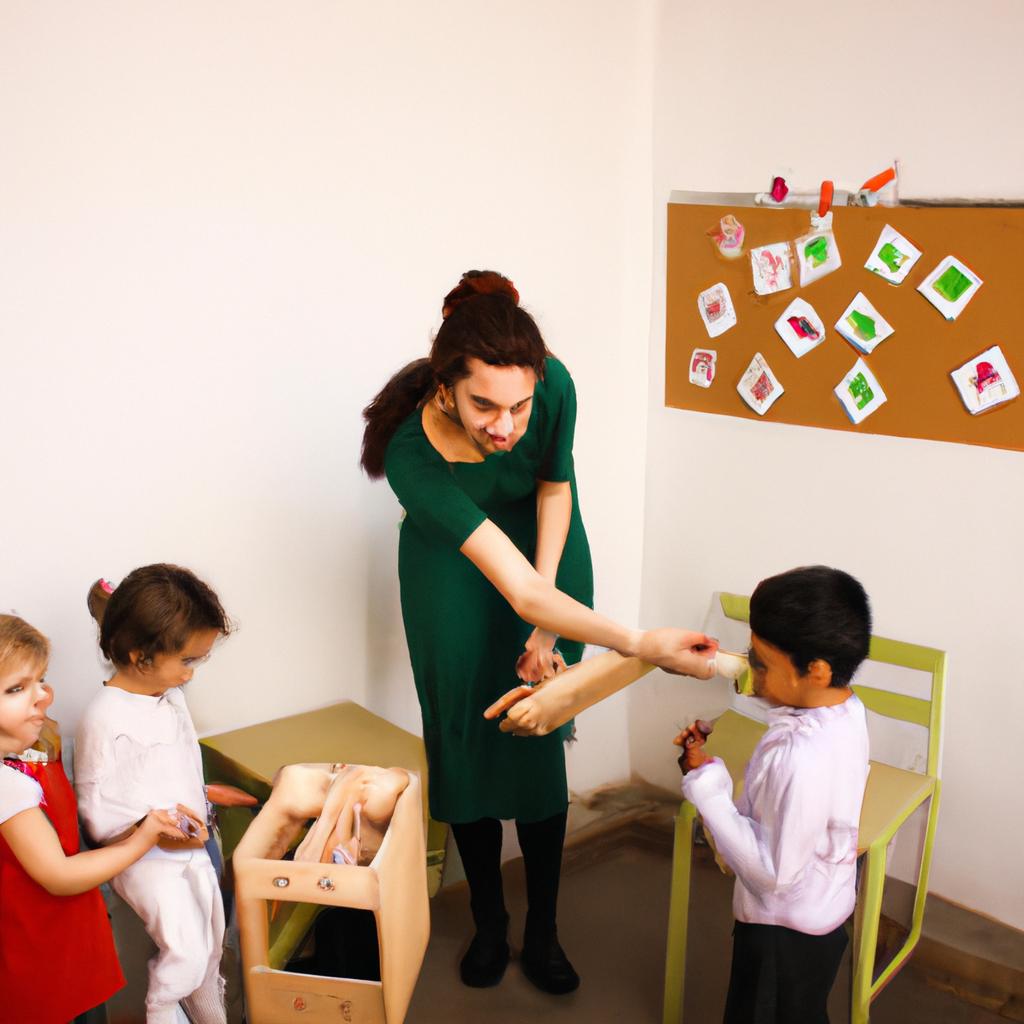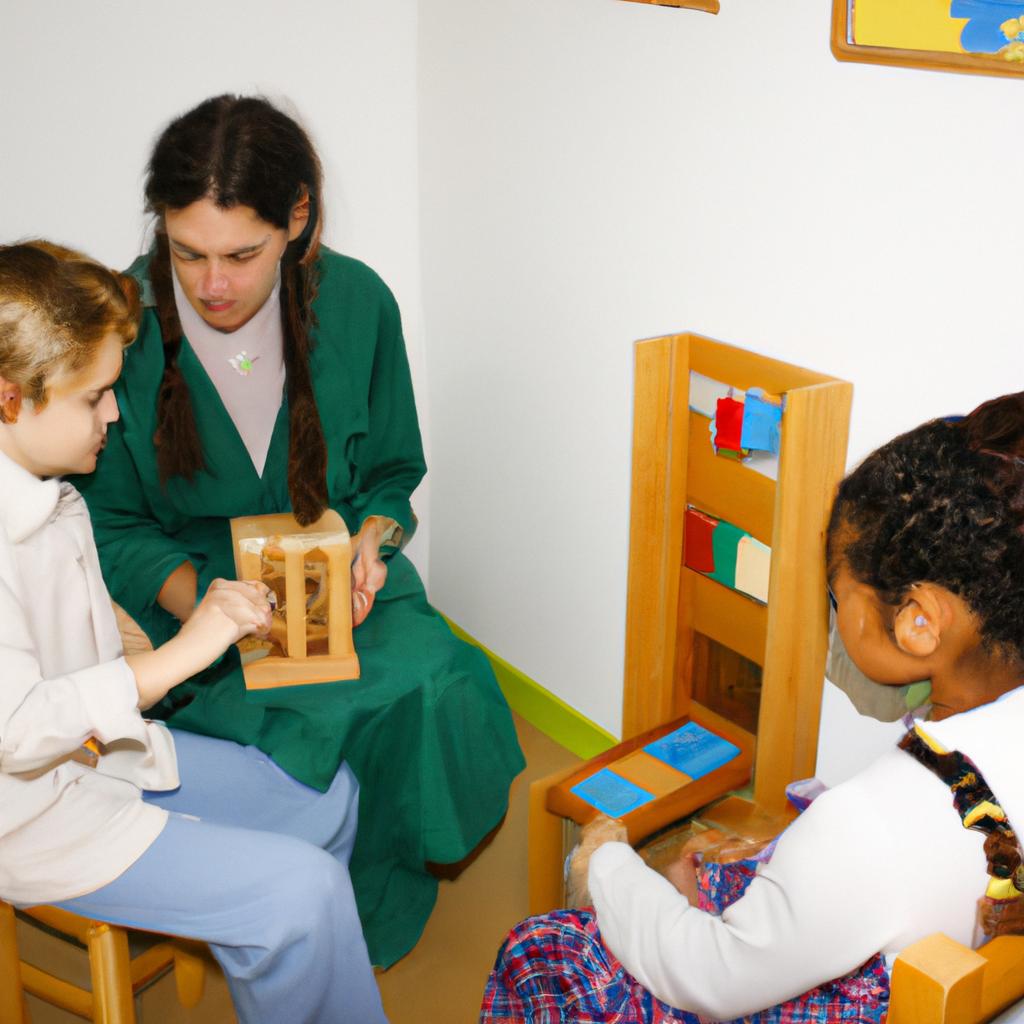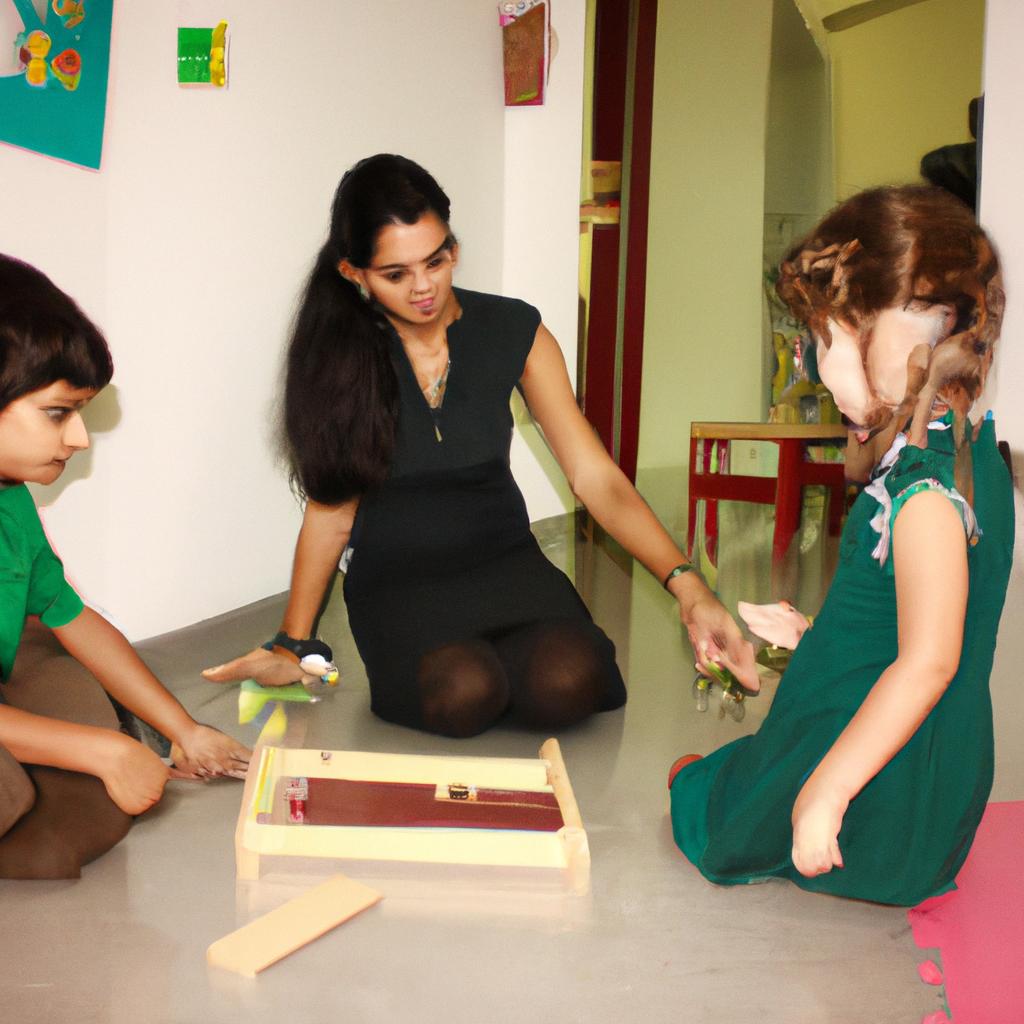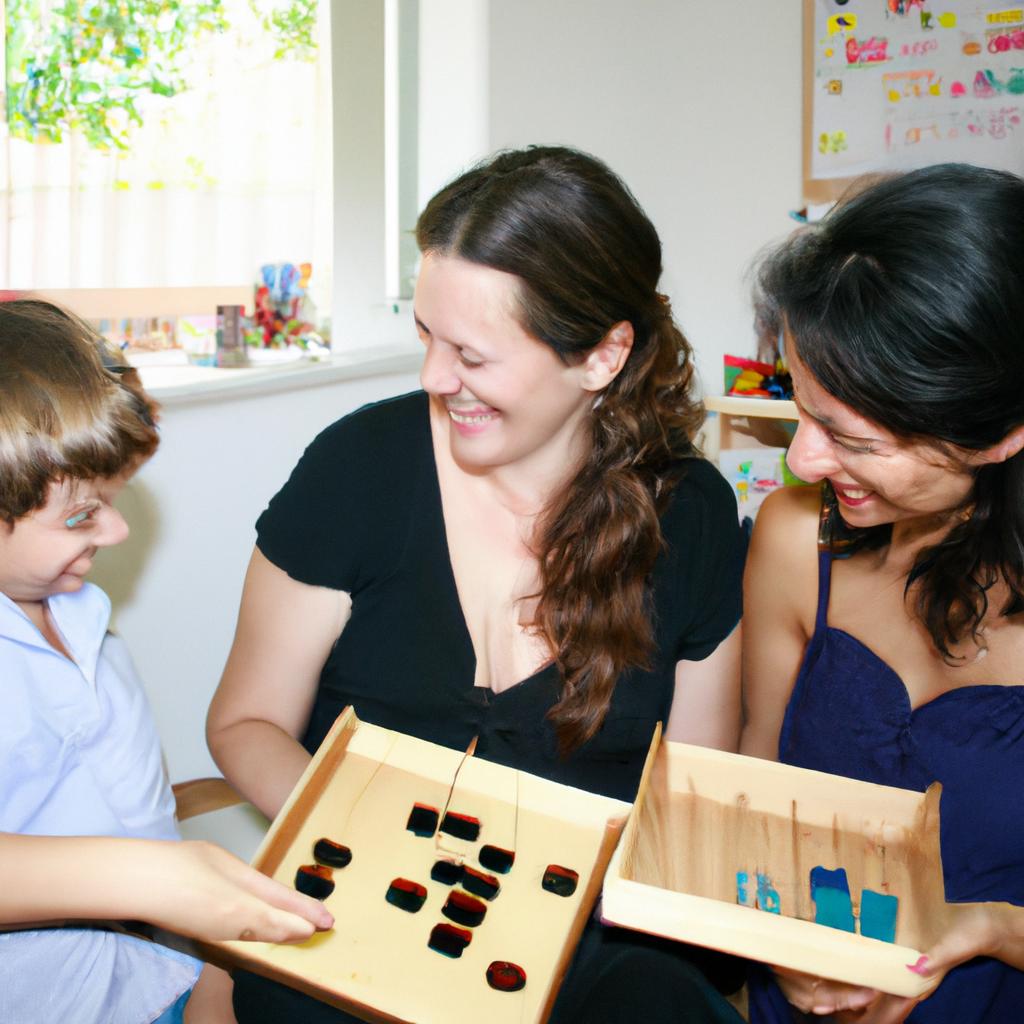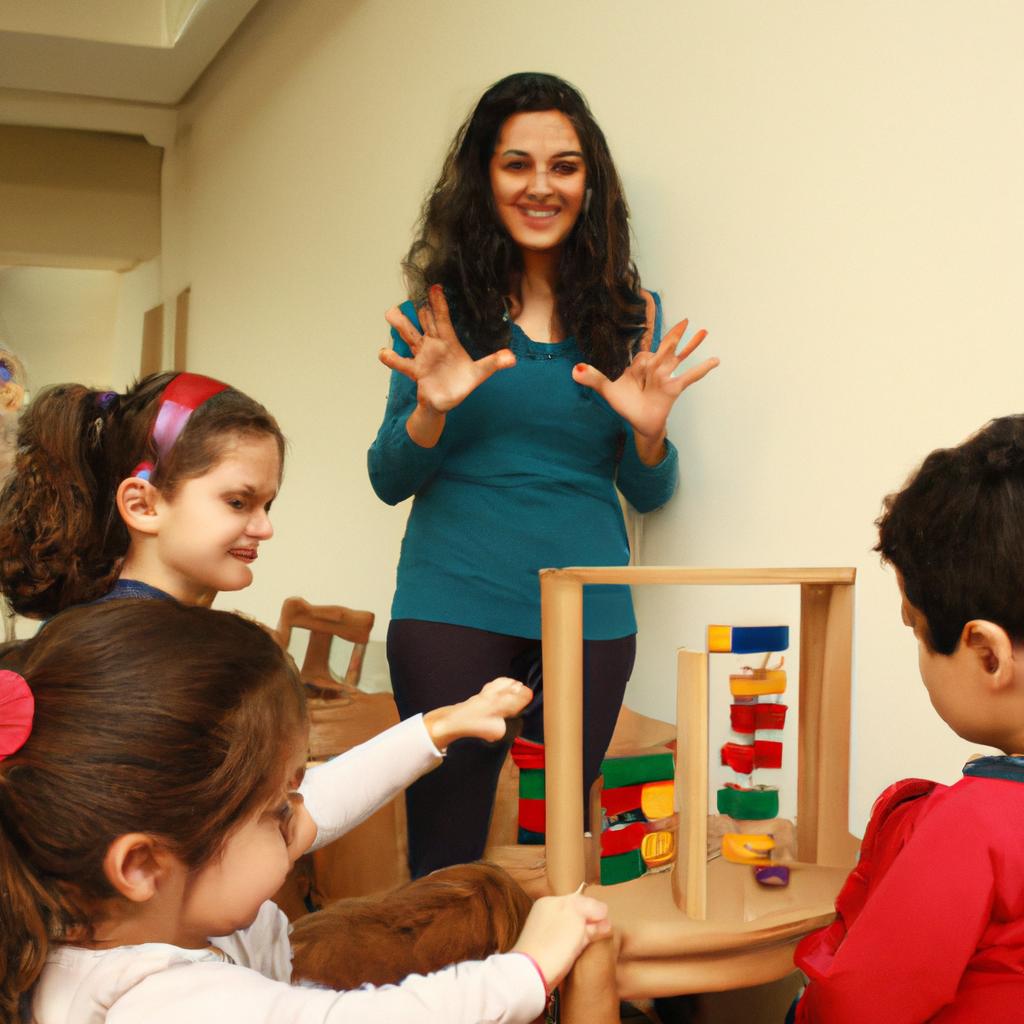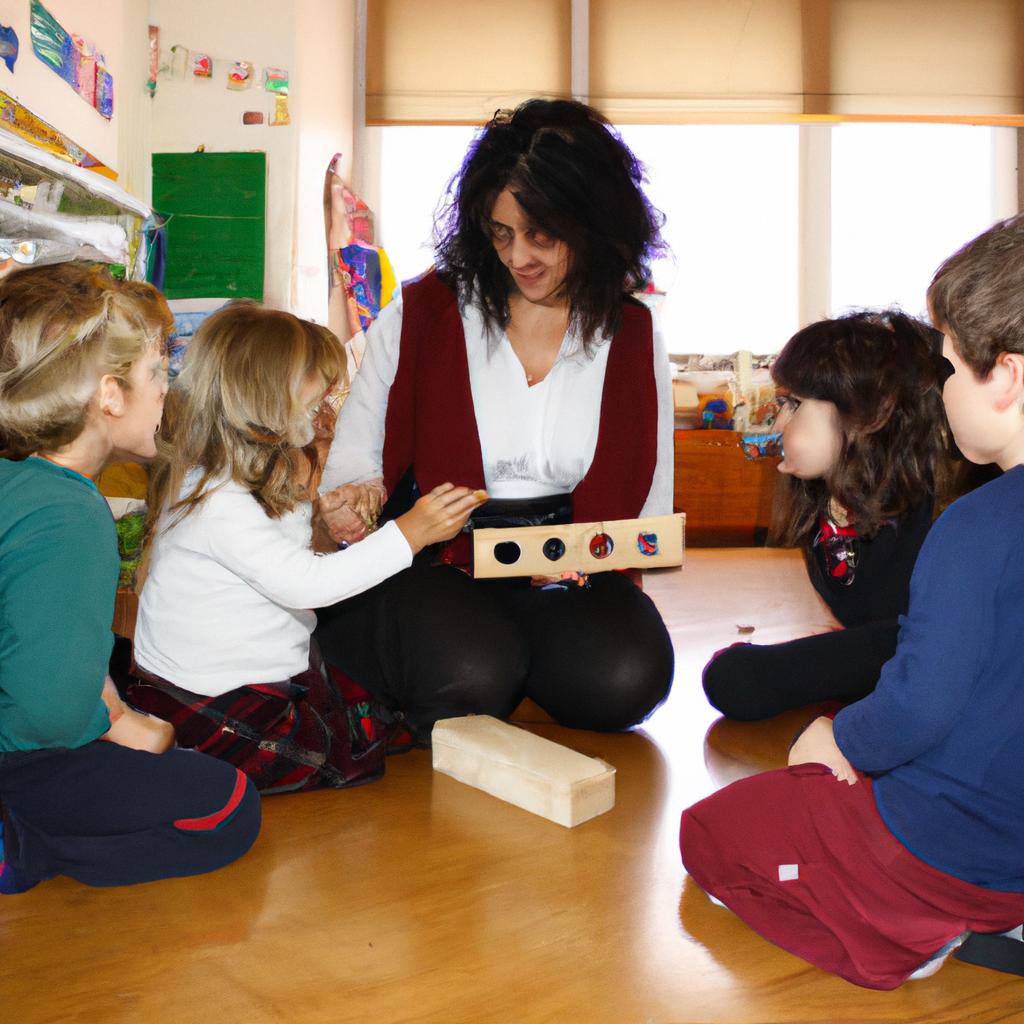Classroom management plays a crucial role in creating an effective learning environment within a Montessori school. The Montessori approach to education emphasizes freedom, independence, and self-directed learning for students. However, this does not mean that the teacher’s role becomes obsolete or passive. On the contrary, the Montessori teacher takes on a unique and active position as a facilitator and guide in the classroom. To illustrate this point, consider the case of Emma, a seven-year-old student who struggled with focusing on her tasks and often disrupted other children during work time. In order to successfully address these challenges, it was essential for her Montessori teacher to implement effective classroom management strategies.
In a Montessori classroom, one key aspect of successful classroom management is establishing clear guidelines and expectations from the beginning. This helps create a structured yet flexible environment where students can thrive academically and socially. For example, when working with Emma, her teacher set clear rules regarding respectful behavior towards others during work time. By consistently reinforcing these guidelines through gentle reminders and individual discussions, Emma gradually internalized appropriate behaviors and began to demonstrate respect for herself and others.
Another vital responsibility of the Montessori teacher in terms of classroom management is observing each child’s progress closely and providing individualized support as needed. In Emma’s case, her teacher made it a point to closely observe her behavior and work habits during class time. By doing so, the teacher was able to identify patterns and triggers that contributed to Emma’s difficulties in focusing and staying on task. This allowed the teacher to tailor interventions specifically to meet Emma’s needs.
Furthermore, the Montessori teacher fosters a sense of independence among students by encouraging them to take ownership of their learning and classroom responsibilities. For instance, Emma’s teacher involved her in decision-making processes regarding tasks and activities, allowing her to have a sense of control over her own learning environment. Additionally, the teacher provided opportunities for Emma to practice self-regulation skills, such as taking breaks or using calming techniques when feeling overwhelmed.
Collaboration between the Montessori teacher and parents is also an important aspect of effective classroom management. The teacher maintained open lines of communication with Emma’s parents, discussing strategies that could be implemented both at home and at school. This collaboration helped ensure consistency in expectations and support for Emma.
In summary, effective classroom management in a Montessori setting involves establishing clear guidelines and expectations, observing individual progress closely, fostering independence, and collaborating with parents. By implementing these strategies with Emma, her Montessori teacher was able to create a supportive learning environment where she could thrive academically and socially while respecting the principles of freedom and self-directed learning.
Understanding the Montessori approach to education
One example of the Montessori approach is a case study of a three-year-old child named Emily. In a traditional classroom, Emily would have been given worksheets and expected to sit still for long periods of time. However, in a Montessori classroom, she was provided with hands-on materials that allowed her to explore and learn at her own pace. As she engaged with these materials, Emily developed independence, concentration, and a love for learning.
The Montessori approach emphasizes several key principles:
- Child-centered learning: The focus is on each individual child’s unique needs and interests. Teachers observe children closely and tailor their instruction accordingly.
- Prepared environment: The classroom is carefully designed to promote independent exploration and learning. It includes low shelves displaying attractive materials that are organized and accessible to the children.
- Freedom within limits: Children are given freedom to choose their activities but within certain boundaries set by the teacher. This fosters responsibility and self-discipline.
- Mixed-age classrooms: Students of different ages learn together, allowing younger ones to be inspired by older peers while providing opportunities for leadership and mentoring.
This table illustrates some differences between traditional education and the Montessori approach:
| Traditional Education | Montessori Approach |
|---|---|
| Teacher-led | Child-led |
| Uniform curriculum | Individualized |
| Rigid schedule | Flexible schedule |
By understanding the fundamental principles of the Montessori approach, teachers can create an environment that supports independent learning. In the subsequent section about “Creating a prepared environment for independent learning,” we will delve deeper into how educators can effectively implement this aspect of the Montessori method.
Creating a prepared environment for independent learning
Transitioning from the previous section that explored the Montessori approach to education, we now delve into the crucial role of a Montessori teacher in classroom management. To illustrate this, let us consider a hypothetical example of a Montessori classroom where children are engaged in various activities independently while the teacher observes and guides their learning.
In order to effectively manage a Montessori classroom, teachers employ several strategies:
-
Establishing clear expectations: The Montessori teacher begins by setting clear expectations for behavior and work habits within the prepared environment. This includes demonstrating how materials should be handled respectfully and teaching children to take responsibility for maintaining orderliness in the classroom.
-
Promoting independence: A key aspect of Montessori philosophy is fostering independent learning. Teachers create an environment that encourages self-directed exploration and decision-making among students. By providing appropriate materials and guidance, educators empower children to engage in purposeful activities at their own pace.
-
Facilitating collaborative learning: Although individual work is emphasized in Montessori classrooms, collaboration is also encouraged. Teachers facilitate opportunities for peer interaction through group projects or discussions, promoting social skills such as communication, cooperation, and empathy among students.
-
Emphasizing individualized instruction: Recognizing that each child has unique strengths and needs, Montessori teachers tailor their instruction accordingly. Through observation and assessment, they identify areas where additional support may be required or advanced challenges can be provided to cater to individual differences in learning styles and abilities.
To further understand the importance of these strategies in creating an effective Montessori learning environment, consider the following table:
| Strategies | Benefits | Emotional Response |
|---|---|---|
| Clear expectations | Establishes structure and discipline | Sense of security |
| Promoting independence | Encourages autonomy | Boosts confidence |
| Facilitating | Fosters teamwork and communication | Sense of belonging |
| collaborative learning | ||
| Individualized | Addresses unique needs and abilities | Personalized attention |
| instruction |
In conclusion, the Montessori teacher plays a pivotal role in classroom management by establishing clear expectations, promoting independence, facilitating collaboration, and delivering individualized instruction. By employing these strategies effectively, teachers create an engaging environment that supports children’s holistic development. In the subsequent section on “Observation and individualized instruction,” we will explore how Montessori teachers utilize observation to inform their instructional practices without disrupting the learning process.
Observation and individualized instruction
Transitioning from the previous section on creating a prepared environment for independent learning, it is now important to explore the role of the Montessori teacher in classroom management. By understanding how teachers facilitate and guide students’ learning experiences within a Montessori setting, we can gain insight into the unique practices that promote independence and self-discipline.
In order to illustrate this further, let us consider an example. Imagine a Montessori classroom where a group of preschoolers are engaged in various activities at different stations. One child, Emma, is working diligently on a puzzle while another child, Liam, struggles with tying his shoes. The Montessori teacher observes both situations and determines how best to support each child’s individual needs.
To effectively manage such diverse scenarios and foster independent learning, here are several key strategies employed by Montessori teachers:
- Encouraging autonomy: Montessori teachers prioritize student choice and freedom within limits. This approach allows children to take ownership of their own learning journey.
- Promoting collaboration: Teachers create opportunities for peer interaction and cooperation through group projects or problem-solving exercises. This fosters social development alongside cognitive growth.
- Providing individualized instruction: Recognizing that every child learns at their own pace and has unique strengths and challenges, Montessori teachers tailor their lessons to meet each student’s specific needs.
- Cultivating intrinsic motivation: Rather than relying solely on external rewards or punishments, Montessori educators focus on nurturing internal drive and curiosity within students.
Let us visualize these strategies using a table format:
| Strategies Employed by Montessori Teachers |
|---|
| Encouraging Autonomy |
| Promoting Collaboration |
| Providing Individualized Instruction |
| Cultivating Intrinsic Motivation |
By employing these strategies, Montessori teachers strive to create an educational environment that promotes independent thinking, self-discipline, and lifelong love for learning.
Transitioning into the subsequent section on nurturing independence and self-discipline, it is crucial to explore additional approaches used by Montessori teachers. By focusing on these aspects, we can gain a comprehensive understanding of the holistic teaching practices found within a Montessori classroom setting.
Nurturing independence and self-discipline
Observation and individualized instruction play a crucial role in the Montessori approach to education. By closely observing each child’s unique learning style, interests, and abilities, the Montessori teacher is able to tailor their instruction to meet the specific needs of each student. This personalized approach fosters an environment where children can thrive academically and emotionally.
For instance, let us consider a hypothetical case study of a Montessori classroom. In this scenario, there is a five-year-old boy named Ethan who struggles with reading comprehension. The teacher notices that he often becomes frustrated when asked to read aloud or answer questions about what he has read. Through careful observation, the teacher determines that Ethan learns best through hands-on activities rather than traditional methods of teaching. To accommodate his learning style, the teacher creates interactive reading materials that allow him to engage with the text using manipulatives and visual aids. As a result, Ethan’s confidence grows, and his reading comprehension improves significantly.
In order to effectively manage a diverse classroom while promoting individualized instruction, Montessori teachers employ various strategies:
- Differentiated Learning: Montessori classrooms support individual progress by providing a range of materials and activities at different levels of difficulty. This allows students to work at their own pace and ensures they are appropriately challenged.
- Flexible Groupings: Teachers organize students into small groups based on similar skill levels or interests for collaborative projects or lessons. This approach encourages peer-to-peer learning and promotes social interaction among classmates.
- Individual Work Time: A key component of Montessori education is allowing children ample time for independent exploration and self-directed learning. During designated work periods, students have autonomy in selecting tasks within set guidelines provided by the teacher.
- Regular Assessment: Continuous assessment helps teachers identify areas where students may need additional support or enrichment. Observations, checklists, anecdotal records, and standardized assessments all contribute to gaining insights into each child’s progress and adjusting instruction accordingly.
By implementing these strategies, Montessori teachers create a classroom environment that nurtures independence, self-discipline, and academic growth.
Promoting collaboration and social development
Transitioning from the previous section on nurturing independence and self-discipline, a crucial aspect of classroom management in a Montessori school is promoting collaboration and social development. In these environments, teachers strive to cultivate an atmosphere that fosters teamwork, empathy, and effective communication among students.
For instance, consider a hypothetical scenario where a group of preschool-aged children are engaging in a collaborative activity. The teacher encourages them to work together to build a tower using wooden blocks. Through this experience, the children learn not only how to share materials but also how to listen attentively to their peers’ ideas and negotiate differences in opinion. This emphasis on collaboration helps develop vital social skills that will benefit them throughout their lives.
To further understand the strategies employed by Montessori teachers for fostering collaboration and social development, it is helpful to explore some key principles:
- Encouraging active listening: Teachers emphasize the importance of attentive listening during discussions or group activities. They provide prompts such as “Can you repeat what your friend just said?” or “Let’s all take turns sharing our thoughts.” These practices teach children respect for others’ opinions and enhance their ability to engage in meaningful conversations.
- Cultivating empathy: Montessori educators recognize the significance of compassion and understanding within a community setting. They incorporate activities that encourage students to imagine themselves in someone else’s shoes—for example, asking questions like “How do you think your friend feels right now?” Such exercises promote empathy and help create an inclusive environment.
- Teaching conflict resolution: Conflicts inevitably arise when individuals collaborate closely. Montessori teachers guide students through resolving conflicts peacefully by teaching problem-solving techniques. Children may be encouraged to express their feelings constructively or brainstorm solutions together before reaching compromises.
- Celebrating diversity: Montessori classrooms value diversity and celebrate individual differences. Teachers integrate multicultural literature, artifacts, and celebrations into the curriculum, allowing students to appreciate various cultures while developing acceptance and tolerance towards others.
To visualize the impact of these strategies, consider the following table showcasing the positive outcomes associated with promoting collaboration and social development in a Montessori classroom:
| Positive Outcomes |
|---|
| Improved communication skills |
| Enhanced teamwork abilities |
| Heightened empathy towards others |
| Increased appreciation for diversity |
Overall, by prioritizing collaboration and social development, Montessori teachers create an environment where children learn to work together harmoniously while embracing their unique strengths. This focus on fostering healthy relationships prepares students not only for academic success but also for navigating future interpersonal interactions.
Transitioning into the subsequent section about maintaining a balanced and harmonious classroom atmosphere, it is essential to explore additional aspects of effective classroom management in a Montessori setting.
Maintaining a balanced and harmonious classroom atmosphere
Building upon the importance of promoting collaboration and social development in a Montessori classroom, maintaining a balanced and harmonious atmosphere is equally crucial. In order to achieve this, the role of the Montessori teacher becomes even more significant as they guide students towards self-discipline and respect for others.
In practice, one example that highlights the significance of maintaining a balanced classroom atmosphere is when conflicts arise between students during group work. For instance, imagine two students having different ideas on how to complete a project. The Montessori teacher steps in by facilitating open communication and encouraging active listening among the students. By fostering an environment where everyone’s opinions are valued, the teacher guides them towards resolving their differences amicably. This not only helps maintain harmony within the classroom but also nurtures important life skills such as compromise and empathy.
- Establishing clear expectations: Teachers set guidelines from day one, ensuring all students understand what behavior is expected of them.
- Encouraging mutual respect: Emphasizing respect for oneself and others cultivates an inclusive and supportive learning environment.
- Promoting conflict resolution skills: Teaching students constructive ways to resolve conflicts fosters healthy relationships within the classroom community.
- Modeling positive behavior: Montessori teachers lead by example, demonstrating kindness, patience, and understanding towards all students.
| Strategies | Impact |
|---|---|
| Clear Expectations | Provides structure and reduces confusion |
| Mutual Respect | Builds trust and enhances student engagement |
| Conflict Resolution Skills | Develops problem-solving abilities and strengthens interpersonal connections |
| Modeling Positive Behavior | Inspires students to emulate desirable traits |
Through these approaches, Montessori teachers create an emotionally safe space where each child feels supported while developing essential social-emotional competencies. As they guide children through various activities throughout the day, Montessori teachers prioritize the cultivation of self-regulation skills and emphasize the importance of respect for oneself and others. By fostering a balanced classroom atmosphere, students not only thrive academically but also develop into individuals who contribute positively to their communities.
Reference:
Insert any reference sources if applicable.

